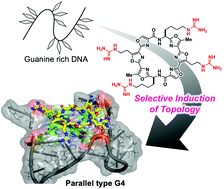当前位置:
X-MOL 学术
›
Org. Biomol. Chem.
›
论文详情
Our official English website, www.x-mol.net, welcomes your
feedback! (Note: you will need to create a separate account there.)
Development of G-quadruplex ligands for selective induction of a parallel-type topology
Organic & Biomolecular Chemistry ( IF 2.9 ) Pub Date : 2018-08-29 , DOI: 10.1039/c8ob01702f Yue Ma 1, 2, 3, 4, 5 , Yamato Tsushima 1, 2, 3, 4, 5 , Mai Sakuma 1, 2, 3, 4, 5 , Shogo Sasaki 1, 2, 3, 4, 5 , Keisuke Iida 5, 6, 7, 8, 9 , Sachiko Okabe 10, 11, 12, 13, 14 , Hiroyuki Seimiya 10, 11, 12, 13, 14 , Takatsugu Hirokawa 5, 15, 16, 17, 18 , Kazuo Nagasawa 1, 2, 3, 4, 5
Organic & Biomolecular Chemistry ( IF 2.9 ) Pub Date : 2018-08-29 , DOI: 10.1039/c8ob01702f Yue Ma 1, 2, 3, 4, 5 , Yamato Tsushima 1, 2, 3, 4, 5 , Mai Sakuma 1, 2, 3, 4, 5 , Shogo Sasaki 1, 2, 3, 4, 5 , Keisuke Iida 5, 6, 7, 8, 9 , Sachiko Okabe 10, 11, 12, 13, 14 , Hiroyuki Seimiya 10, 11, 12, 13, 14 , Takatsugu Hirokawa 5, 15, 16, 17, 18 , Kazuo Nagasawa 1, 2, 3, 4, 5
Affiliation

|
G-Quadruplex structures (G4s) in guanine-rich regions of DNA play critical roles in various biological phenomena, including replication, translation, and gene expression. The G4-forming DNAs can form three kinds of topologies, i.e., parallel, anti-parallel, and hybrid. In this paper, we present G4 ligands L2H2-2M2EA-6OTD (3) and L2G2-2M2EG-6OTD (4) bearing tetra-aminoalkyl and -guanidinylalkyl side chains, respectively, in a macrocyclic hexaoxazole structure. These ligands efficiently induce the parallel-type topology of telomeric G4 regardless of the effects of cations. Titration with 4 results in a drastic topology switch to the parallel topology from the anti-parallel structure induced by the structurally related ligand L2H2-6OTD (1).
中文翻译:

用于选择性诱导平行型拓扑的G-四链体配体的开发
DNA富含鸟嘌呤的区域中的G四联体结构(G4)在各种生物学现象(包括复制,翻译和基因表达)中起关键作用。形成G4的DNA可以形成三种拓扑,即并行,反并行和混合。在本文中,我们提出了在大环六恶唑结构中分别带有四氨基烷基和-胍基烷基侧链的G4配体L2H2-2M2EA-6OTD(3)和L2G2-2M2EG-6OTD(4)。这些配体可有效诱导端粒G4的平行型拓扑结构,而不受阳离子的影响。用4滴定结果导致急剧的拓扑结构从结构相关的配体L2H2-6OTD(1)诱导的反平行结构转换为平行拓扑。
更新日期:2018-10-18
中文翻译:

用于选择性诱导平行型拓扑的G-四链体配体的开发
DNA富含鸟嘌呤的区域中的G四联体结构(G4)在各种生物学现象(包括复制,翻译和基因表达)中起关键作用。形成G4的DNA可以形成三种拓扑,即并行,反并行和混合。在本文中,我们提出了在大环六恶唑结构中分别带有四氨基烷基和-胍基烷基侧链的G4配体L2H2-2M2EA-6OTD(3)和L2G2-2M2EG-6OTD(4)。这些配体可有效诱导端粒G4的平行型拓扑结构,而不受阳离子的影响。用4滴定结果导致急剧的拓扑结构从结构相关的配体L2H2-6OTD(1)诱导的反平行结构转换为平行拓扑。









































 京公网安备 11010802027423号
京公网安备 11010802027423号